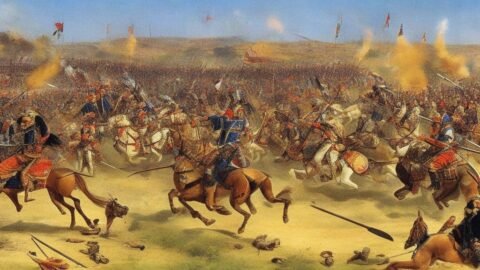Table of Contents
Introduction:
In the 11th century, a clash of empires unfolded on the plains of northern India, shaping the course of history in the Indian subcontinent. It was the Battle of Jayapala and Mahmud of Ghazni, a monumental confrontation between the valiant Indian ruler Jayapala, king of the Shahi dynasty, and the mighty Muslim conqueror Mahmud of Ghazni. This epic battle stands as a pivotal moment, representing the collision of Indian and Islamic powers and leaving an indelible mark on the region’s cultural and political landscape.
The Rise of Mahmud and the Hindu Resistance:
In the early 11th century, Mahmud of Ghazni, driven by a thirst for wealth and a mission to spread Islam, launched a series of invasions into the Indian subcontinent. His primary targets were the Hindu kingdoms, including the Shahis, who held sway over vast territories spanning present-day Afghanistan, Pakistan, and northern India. However, Jayapala, the indomitable ruler of the Shahi dynasty, rallied a coalition of Hindu kingdoms, standing as a formidable force against Mahmud’s incursions.

The Battles and the Triumph of Mahmud:
The clash between Jayapala and Mahmud began with the Battle of Peshawar in 1001 CE, where Jayapala’s forces suffered a setback, although the king managed to escape. Undeterred, he regrouped his army, vowing to resist Mahmud’s relentless advances. However, the decisive encounter came in 1008 CE, near the banks of the Indus River. Mahmud’s disciplined troops, superior cavalry, and powerful artillery overwhelmed Jayapala’s forces, culminating in a resounding victory for the Ghaznavid conqueror. Jayapala was captured, and his defeat spelled the beginning of the end for the Shahi dynasty.

Consequences and Legacy:
Jayapala’s defeat had far-reaching consequences. Although he was eventually released, the humiliation of his defeat led to his tragic demise by suicide. The Shahi dynasty rapidly declined, paving the way for the ascension of the Ghaznavid Empire. Mahmud of Ghazni continued his incursions into northern India, conducting numerous raids characterized by plundering immense wealth, destroying temples, and subjugating local rulers. While he couldn’t establish a permanent empire in India, his campaigns left an enduring impact on the region’s political and cultural fabric.
The Aftermath:
Following the Battle of Jayapala, the Ghaznavid Empire gained prominence, with its capital in Ghazni. Mahmud’s conquests were driven by both wealth and the propagation of Islam, leading to the spread of the religion throughout the subcontinent. His expeditions also fostered cultural exchanges, as Muslim scholars and artists accompanied him, infusing Persian and Central Asian influences into Indian art, architecture, and literature. Furthermore, the weakening of Hindu kingdoms set the stage for the rise of subsequent Islamic dynasties, including the illustrious Delhi Sultanate, which shaped the medieval history of India.
Conclusion:
The Battle of Jayapala and Mahmud of Ghazni serves as an epic tale of clash and conquest, forever etched in the annals of history. It showcased Mahmud’s military prowess and the waning strength of Hindu kingdoms facing Islamic invasions. While the battle brought suffering and devastation, it also brought about a cultural amalgamation that laid the foundation for future Muslim empires in India. This seminal event serves as a testament to the transformative power of conflict, leaving an enduring legacy that shaped the destiny of the Indian subcontinent.

